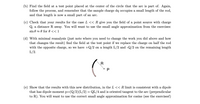Question
Answer all parts of the physics problem please

Transcribed Image Text:A uniformly charged rod of length L is bent into an arc of radius R. Total charge on the rod is Q.
This is similar to the arc problem we considered in class.
(a) Find the angle in radians, 0, subtended by the arc and the linear charge density A in terms of Q,
L and R. See the exercises and the hints and guide at the end of the homework for a reminder
of the relationship between angle and arc length.

Transcribed Image Text:(b) Find the field at a test point placed at the center of the circle that the arc is part of. Again,
follow the process, and remember that the sample charge dq occupies a small length of the rod,
and that length is now a small part of an arc.
(c) Check that your results for the case L << R give you the field of a point source with charge
Q, a distance R away. You will want to use the small angle approximation from the exercises:
sin 0 z 0 for 0 << 1
(d) With minimal reanalysis (just note where you need to change the work you did above and how
that changes the result) find the field at the test point if we replace the charge on half the rod
with the opposite charge, so we have +Q/2 on a length L/2 and -Q/2 on the remaining length
L/2.
R
* P
(e) Show that the results with this new distribution, in the L << R limit is consistent with a dipole
that has dipole moment p=(Q/2)(L/2) = QL/4 and is oriented tangent to the arc (perpendicular
to R). You will want to use the correct small angle approximation for cosine (see the exercises!)
Expert Solution
This question has been solved!
Explore an expertly crafted, step-by-step solution for a thorough understanding of key concepts.
This is a popular solution
Trending nowThis is a popular solution!
Step by stepSolved in 5 steps with 4 images

Knowledge Booster
Similar questions
- help please answer in text form with proper workings and explanation for each and every part and steps with concept and introduction no AI no copy paste remember answer must be in proper format with all workingarrow_forward(2) Calculate the random error on the period using the formu (3) Calculate the standard deviation (SD) of the measuremen SD error which is given by standard error= Q2. Two objects have masses (100±0.4) g and (98±0.3) g. (1) What is the absolute error on the sum of their masses? (2) What is the relative error on the sum of their masses?arrow_forwardPlease answer 2B and show all workarrow_forward
arrow_back_ios
arrow_forward_ios